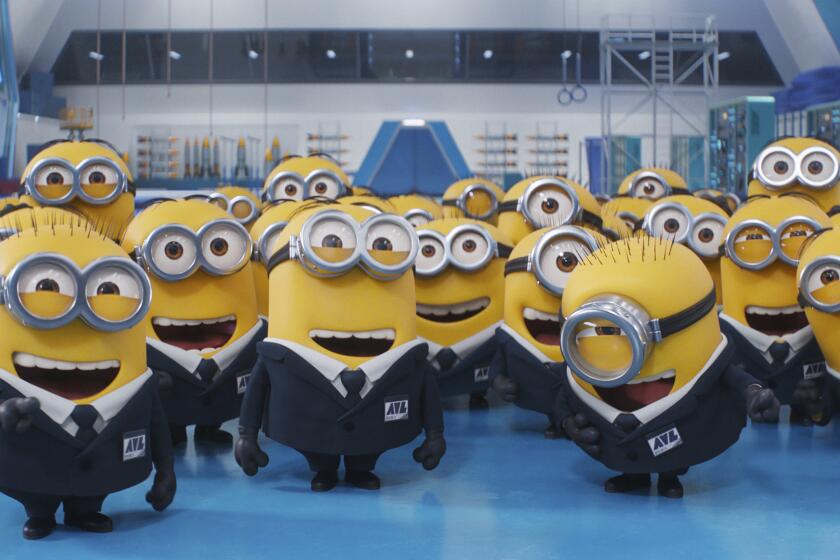COVER STORY : The Man Behind the Monster : It may be hard to recall life before MTV, but Bob Pittman, who shaped and sold the concept, remembers it well
“Video Killed the Radio Star” by the Buggles will be remembered, if for nothing else, as the video clip that launched MTV. The date: Aug. 1, 1981.
Of course, MTV didn’t kill the radio stars. It enshrined them. It energized rock ‘n’ roll culture. Everybody associated with music benefited--from radio stations to Rolling Stone magazine. MTV turned pop music artists into recognizable faces. Before MTV, the top artists were rarely recognized. But within weeks of the launch of MTV, artists began hearing the refrain “I saw you on MTV.”
And MTV had an even wider impact on our culture--in music, fashion, politics, art, advertising, television and movies. In music, it popularized a whole new kind of music and made visual appeal a prerequisite for musical artists.
Through MTV, Middle America was exposed to what had largely been big-city fashion and trends. Videos of fashion lines popped up in stores; when Norma Kamali opened her New York store, she showed her line on video monitors instead of mannequins. The look and feel of music videos were quickly adopted into television series, motion pictures, even political advertising. Candidates began to sell themselves with an attitude and an image. And video bloomed as an art form.
MTV is now such a part of American culture that it seems hard to believe that MTV was an idea that almost wasn’t.
American Express had agreed to buy half of Warner Cable in late 1979. Out of that purchase came two companies: one that operated cable systems, another that was established to create networks for the cable industry. I was hired as the programmer to put together the first 24-hour cable service, an all-movie pay service that became the Movie Channel.
After the first few months of growth for the Movie Channel in 1980, I was charged with developing the product and marketing for the company’s first advertiser-supported cable venture.
At that point, when CNN and ESPN were in their early days, the major concern was not the product but whether any basic-cable venture could succeed. At that time, advertisers had a rule: They bought national advertising only on services or programs that had a 3.0 rating (meaning that 3% of U.S. households with TV were tuned in) and 70% coverage of households--a feat that no cable network has yet achieved.
(It was actually this seemingly hopeless financial situation that caused the owners to give me the responsibility for the entire business side of MTV about a year and a half after its launch.)
A development team I had put together earlier in the year had miraculously worked through all the major hurdles of getting a video music channel on the air--dealing with the musicians unions, finding out who had the rights to the videos, getting the videos, determining what our standards would be, working with cable operators on how to get stereo sound and figuring out how we would shoot the veejay segments.
Included in this team were Tom Freston, now the chief executive officer of MTV Networks; John Sykes, president of Chrysalis Records; Carolyn Baker of Warner Bros. Records; Steve Casey, a successful radio programmer; Fred Seibert, a principal in Fred/Alan, the advertising agency for MTV; Mark Booth, who would later launch MTV in Europe, and for a brief period Robert Morton, now the producer of “Late Night With David Letterman.”
But the skepticism about the basic-cable business led the board of directors of the Warner Communications and American Express joint venture to turn down the idea for MTV in late 1980.
Fortunately, my immediate bosses, Jack Schneider and John Lack, got us into the court of last appeal--a meeting with Steve Ross, then the chairman of Warner Communications; Jim Robinson, chairman of American Express, and their key executives, including David Horowitz from the Warner side and Lou Gerstner from the American Express side.
We all felt confident that Ross would support the idea. After all, it was Ross who had developed and championed the vision of “narrowcasting”--in which a cable network takes on one subject matter and does only that, continuously, rather than trying to be all things to all people--and Warner had a big investment in music. Additionally, Horowitz had emerged as our guardian angel--nurturing the idea along at the various divisions of Warner Communications.
It was American Express that was the great unknown. The company’s public image was hardly synonymous with rock ‘n’ roll. After we spent a grueling few hours playing videos, reviewing research and laying out the entire programming plan, the answer came very quickly. Jim Robinson looked at Ross and said, “OK, I’m in for our half.” And that was it--we were on our way. (Jim told me a number of years later that he saw it as an extension of radio and that because of my success in radio he was willing to sign on.)
The funny thing about the beginning of MTV is that the idea of a music service had been around for a while. I had produced and been host of “Album Tracks,” a music show on the NBC-owned TV stations in 1978. A video music show had run on our sister network, Nickelodeon, in 1980. The Warner Amex Qube cable system in Columbus, Ohio, had produced a continuing series of video music programs in 1979 and 1980. And there was actually a video music network that was on the air before MTV--Video Concert Hall, I believe was the name. The success of MTV was the execution of the idea--our particular vision of the programming and the unique attitude and culture of the network that we developed.
We realized that almost all TV was narrative in form--after the structure of beginning, middle and end. The appeal of music, however, has nothing to do with that structure. Music is about emotion and attitude--it makes you feel . It moves you. With the creation of MTV, we changed the form of TV to fit the form of music, as opposed to trying to fit music into a narrative structure.
Also, we understood that music videos were program elements, not complete programs by themselves. MTV was the program.
Early on we made a key decision that we would be the voice of Young America. We would not grow old with our audience. We accepted the fact that viewers would grow out of MTV and new viewers would grow into it. For this strategy to succeed, we laid as our cornerstone the concept of “change for change sake.” We would change before the audience was ready for us to change. We would continually reinvent MTV so that it didn’t look like it belonged to the last generation of viewers--or even worse, that it looked accessible to 40- and 50-year-olds. We would stay ahead of the audience--not follow the TV programming tradition of mirroring the audience.
Once we had the corporate go-ahead, we were racing the clock to get on the air.
If you remember, the state of the record industry in 1980 was alarming. After the go-go ‘70s, the record industry had hit a wall in 1980. Radio had stopped playing new music, records were rarely identified when played, the new music out of England couldn’t get exposure in the United States, and the record business’s costs had spiraled out of control. A bad combination--high costs and no new breakthrough records.
It also appeared that in an effort to save money, most of the record companies were set to cut the cost of producing videos from their budgets. At that time, videos, more than radio, were used primarily in Europe to “break” records. They were seen in this country in some record stores and trade shows but weren’t of much importance to the artists; most of them never saw their finished videos. So it looked like the record companies were saying, “We’ve been investing in these things for 10 years, and they never did anything for us.” It was imperative that we get on the air in 1981 with enough time to prove that we could sell records before the companies completed their 1982 budgets.
That period seems like a great blur, but some wonderful moments and events stick in my mind.
The first was our people. We were building more than just a channel; we were building a culture. I had decided that the most important function I could perform was to make sure we had one consistent vision. To that end, I personally interviewed every employee in the original MTV programming group. I was looking for a unique blend--smarts and ignorance. We put together a group of smart, aggressive people, yet none of them had ever done the job he or she was hired to do. Everyone was ignorant of the traditions and conventions of the job, freeing us all to do it a new way. And all of us were being given our shot--the hunger for a success ensured long hours and tireless devotion to the channel.
I had envisioned MTV as “another kind of TV,” an alternative to traditional TV. The plan to create a hipness for MTV was to position it as the very opposite of the three networks--a sort of “stick-it-in-your-eye” approach. To that end, my choice for the name was TV-1--stealing a leadership position by claiming that everything else was secondary.
Unfortunately, we couldn’t clear TV-1--our legal department found another business with that name. The best we could get was TV-M. TV-M it was, until, in one of many late-night, free-thinking sessions, our head of music programming and scheduling, Steve Casey, said in his usual unemotional, laid-back manner: “Don’t you think MTV sounds a little better than TV-M?” He sold us--and it became MTV.
Originally, we thought MTV would be three equal-size letters like ABC , NBC and CBS . Seibert of Fred/Alan, who was in charge of our on-air look, had put the logo out to a number of designers to get back some ideas. Among those designers were three “kids” in a loft downtown, Manhattan Design. They came back with the idea for a big M , with TV spray-painted over it. We cut the paint drips off the TV , and that’s the logo. It’s unbelievable that we paid about $1,000 for one of the decade’s best-known logos.
Besides the MTV theme music at the top of every hour, the one constant in MTV in the first few years was our on-air ID showing the first man stepping onto the moon and placing the MTV flag on the lunar surface instead of the American flag. We decided on this approach because it represented the “next step,” a new era--it was also big, grandiose, a little irreverent when it came to the MTV flag, and best of all, it was cheap. The key elements for this to succeed were the famous words of Neil Armstrong: “One small step for man, one giant leap for mankind.” Every hour, every day, was designed to begin with those words.
To cover ourselves legally, we sent Armstrong a “negative-option” permission letter: “We’re going to use your voice unless we hear from you before Aug. 1.” And we thought no more of it. A few days before we launched, a frantic Seibert came flying into my office. We had just received a letter from Armstrong’s lawyer threatening to sue us if we used his client’s voice. We had no time and, worse, no money to redo this on-air ID. So we took his voice off and used the ID with just music. Not at all what we had envisioned, yet, fortunately, it worked fine.
The videos were the toughest part of my job. Very few record executives naturally warmed to the idea of MTV. I still remember lugging big white presentation charts with John Sykes to all the record companies to explain what MTV could do for them. We pointed out that radio wasn’t playing new music--especially all that “new wave” music from England. We promised that every other video would be a non-hit, something new. We would introduce the new wave to America. (An easy promise, since most of the mainstay American artists had not done videos and most of the unknown, new wave artists had.)
The reason you see the name of the artist, song, album and record label at the beginning and end of the videos on MTV was an action we took in response to many radio stations of the early ‘80s, which deliberately didn’t identify the music they were playing. (The theory was that you’d listen longer in an attempt to try to figure out the names of the songs.) To induce the record companies to give us their support, we went the extra step of identifying the label so that a potential buyer in an out-of-the-way town could even give a store all the information it needed to order the record--the promise of a sure-fire way to turn airplay on MTV into record sales for the record companies.
At the end of all the presentations, most companies gave us their videos. Two companies gave us their videos only because I had “broken” some records for these companies back in the ‘70s when I was a radio programmer, and this was their way of returning the favor. A third one gave us the videos because Horowitz of Warner Communications personally intervened and persuaded this holdout to give MTV a try. Two companies refused to give us their videos at all--MCA and PolyGram. Fortunately, at that point in time, neither company had a large number of videos.
When we finally launched, we had about 250 videos, not enough to have a video music network. We were taking a very deliberate gamble. If MTV worked, it would sell records, and record companies would produce more videos. If MTV didn’t work, record companies would probably not produce more videos--but who would care, because we’d be out of business anyway?
The other big video question we pondered was which worked better, the concept video or the concert-footage video? Only later did we finally conclude that concept or reality was not the variable. Videos that worked were videos in which the visuals created the same emotion and attitude as the music did, whether concept or concert. It was compatibility that mattered, not techniques.
Jerry McGee from the Ogilvy & Mather advertising agency came up with the label veejay . It was a throwaway idea--an offhand comment that stuck. And veejays turned out to be the hardest part of putting together the channel. We auditioned about 1,000 potential veejays. It was hard to describe our vision, because no one knew what an MTV was. And it showed: Most of those auditioning looked like hopeful replacements for Phil Donahue or Johnny Carson.
Finally we settled on five: Alan Hunter, Nina Blackwood, Mark Goodman, J. J. Jackson and a woman who quit before we went on the air because she was not convinced that MTV was going to be better than her radio job. As a last-minute replacement, we found Martha Quinn, who had been given an audition only as a favor to a friend of mine from a radio station where Martha then worked.
“I want my MTV”: Actually, this line came after we were on the air. Cable operators, much to our surprise, were not falling all over themselves to carry MTV. As a matter of fact, “I’m not carrying that garbage on my cable system” was a line heard with some frequency. Our challenge was to persuade the operator that there was a real consumer demand for the network. Tom Freston, our head of marketing, and Fred Seibert, of our creative services group, tackled the issue with the agency--the legendary adman George Lois and his associate at that time, Dale Pon, with whom I had worked in radio a few years earlier.
Pon, Seibert and Freston came over to my apartment one night a few weeks later with a “Cable Brats” campaign idea. I couldn’t find the value in defining our audience as cable brats--but a line in the commercial did hit home. After a long night of haggling, arguing and rewriting--that line, “I want my MTV,” became the headline and the call to action. Over time, the Police, Mick Jagger, David Bowie, the Who and Madonna appeared in commercial spots telling the viewers to call their cable companies and “demand your MTV.”
The campaign worked like a charm. Potential MTV-ites called their cable companies and said, “I want my MTV.” At a cable convention shortly after the campaign began, I was approached by an old-school cable operator who was screaming at me that MTV was terrible. When I asked him why, he said: “It’s destroyed our office. We can’t get any work done. The phone keeps ringing with all the people who want us to hook up cable for them so they can get MTV.” He was dead serious--he didn’t want all those new customers; it was too much work. Fortunately for us, most cable operators did want the new customers.
The attitude of youthful rebellion--”nothing’s sacred”--characterized the attitude of the channel as expressed in the on-air promos and look.
We parodied everything we could think of. We made fun of the broadcast networks. Remember the “Hey, you, don’t watch that, watch this” series of promos? And the most fun was defying all the “rules” about promos and logos. We used cheap-looking black-and-white public-domain footage and changed our slogan from day to day, and horror of all horrors, our logo changed colors, it moved, and it never appeared in the same place or in the same way twice. No rule was left unbroken--an attitude was firmly established.
After MTV launched in August, 1981, Tom Freston and John Sykes went to one of the few markets where we had been available from the launch date--Tulsa, Okla. Their mission was to find even a faint clue that MTV was finding an audience and having an effect on selling records. We needed evidence, even if limited, that MTV could influence record sales, so that we could persuade record companies to budget to produce more videos as they completed their plans for 1982.
I expected that Freston and Sykes would really have to dig to find even a shred of the proof we needed. Much to my surprise, the first day of the reconnaissance mission I got a late-night phone call from Sykes reporting that as soon as MTV hit the air, all the Buggles records in the local stores blew off the shelves--completely sold out. Customers in the stores were talking about MTV, and there was a run on other artists that MTV was playing. It was at this moment that I first realized MTV was a hit--it actually worked.
Over the next few years, there were other key moments that pointed to the success of MTV. Designer Norma Kamali began producing fashion videos and extolling the virtues of MTV as an influence on fashion. “Flashdance” and “Miami Vice” were both indications of the success of MTV.
Beginning in 1983, we began to see the Nielsen ratings, which showed the network to be a consumer success and, in 1984, to be the highest-rated basic cable network. By the time MTV became profitable in the fourth quarter of 1983, it was obvious that it was a success with the consumer.
From the perspective of 10 years, the entire birth of MTV was an absolutely remarkable process. Built on Steve Ross’ vision of narrowcast cable networks with his and Jim Robinson’s unwavering support, a small group of entertainment iconoclasts created (often by accident) an entirely new form of television. But what none of us realized at the time was that MTV was not only a television channel but the voice of our generation. It would go on to have an influence on our entire society, both here in the United States and around the world.
However, from my personal point of view, the greatest accomplishment of MTV was bringing together a truly remarkable group of people--the original team that set the creative culture that underpins MTV even today. It was their skill, innovation and dedication that gave the world MTV and gave me fabulous memories and enduring friendships.
More to Read
The biggest entertainment stories
Get our big stories about Hollywood, film, television, music, arts, culture and more right in your inbox as soon as they publish.
You may occasionally receive promotional content from the Los Angeles Times.






